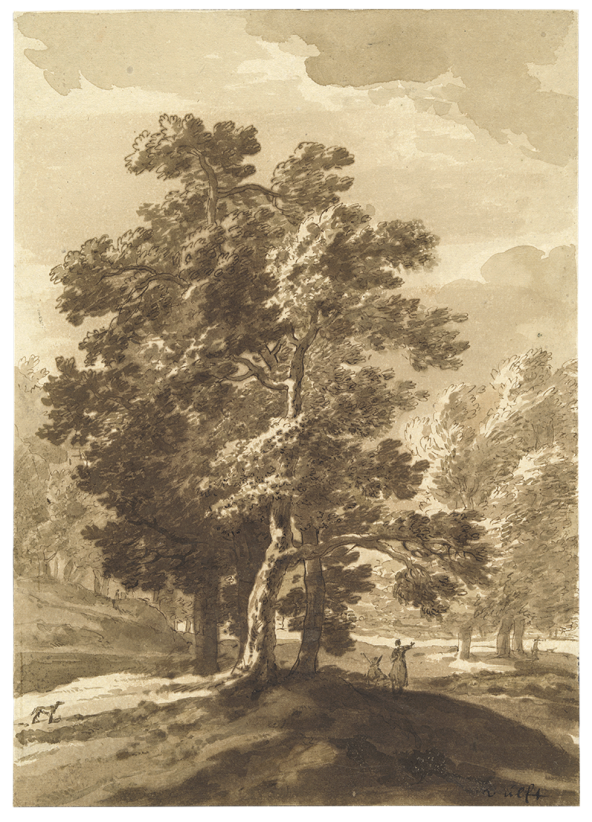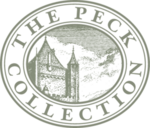Choose a background colour
Jacob van der Ulft, Dutch, 1627-1689
:
Study of Two Trees on a Rise, c. 1680
Pen and brown ink and brown wash on paper; traces of framing lines in brown ink.
12 1⁄4 × 8 1⁄8 in. (311 × 207 mm)
- Watermark:
- Arms of Amsterdam, nearly identical to Heawood no. 342 (dated 1674).
- Provenance:
The family of the Barons van Hardenbroek, probably Gijsbert Carel Duco, Baron van Hardenbroek, 1769-1851, Driebergen; by descent to Ernest Louis, Baron van Hardenbroek van Lockhorst, 1829-1877, Randenbroek; dealer, De Kruyff, Zeist, 1981-82; Hans van Leeuwen, 1911-2010, Amerongen (Lugt 2799a, stamp on verso); his sale, Christie’s, Amsterdam, 24 November 1992, lot 195; Sheldon and Leena Peck, Boston; gift to the Ackland Art Museum, inv. no. 2017.1.82.
- Literature/Exhibitions:
F. Robinson in Chapel Hill, Ithaca & Worcester 1999-2001, 96-97, no. 31; Stefes 2011, vol. 1, 551-552, under no. 1045.
- Ackland Catalogue:
- 2017.1.82
Brilliant sunlight strikes two trees, their entangled branches and leaves swept to the right by a gust of wind. To the lower right, another group of trees appears cursorily drawn, perhaps the same grouping viewed from a different angle. Such unfinished sheets are unusual among Jacob van der Ulft’s extant drawings, but demonstrate his impressive command of light and shadow. To make this lively and dynamic study, he left parts of the white paper untouched, creating areas of highlights that glimmer against the dark foliage and layers of brown wash in the background.
While Roman and Italianate subjects were Van der Ulft’s métier, he also executed a few landscape drawings in his own distinctive style, which often conveys a spirited treatment of trees and their foliage under the bright light of a sunny day. In this drawing the day was breezy as well, to judge by the dynamic sense of movement in the treetops. By brushing the background with even strokes of rapidly applied wash, Van der Ulft created a middle tone to efficaciously offset the bright highlights of the white reserve of the paper in the foliage.
In style it bears comparison to a drawing in the Kröller-Müller Museum of similar scale Fig. 1.1

Jacob van der Ulft, Landscape with Trees and Figures. Pen and brush in brown in on paper, 281 x 205 mm. Otterlo, Kröller-Müller Museum, inv. no. KM 103.724.
Collection Kröller-Müller Museum, Otterlo, the Netherlands
This latter drawing is more finished in terms of having a continuous landscape and staffage figures of travelers, as well as brushwork in the sky that is more suggestive of weather, though the sheet appears to be cropped at the left. Another large sheet of comparable dimensions is in Hamburg Fig. 2.2

Jacob van der Ulft, Two Figures Under an Oak, c. 1680-89. Pen in brown ink, brown wash, on paper, 286 x 204 mm. Hamburg, Hamburger Kunsthalle, inv. no. 22601.
bpk Bildagentur/Hamburger Kunsthalle/Christoph Irrgang/Art Resource, NY
It bears an identical watermark as the Peck drawing and may have been made around the same time.3
A second sheet in Hamburg that appears to belong to this group still bears an inscription in Van der Ulft’s own hand: int haegse Bos (in The Hague Woods) Fig. 3.4

Jacob van der Ulft, Riding in the Hague Woods (Haagse Bos), c. 1680-89. Pen in brown ink, brown wash, traces of graphite, 198 x 297 mm. Hamburg, Hamburger Kunsthalle, inv. no. 22600.
3 bpk Bildagentur/Hamburger Kunsthalle/Christoph Irrgang/Art Resource, NY
This is a location where Van der Ulft likely made some of his other landscape drawings as well, especially those with more northern-like trees that were probably drawn from life such as those in the present sheet.5
The Haagse Bos was (and still is) a stately and arcadian stand of old-growth trees once belonging to the Princes of Orange. In the seventeenth century it was already a carefully maintained park and game preserve just north of the old urban core of The Hague, with the palace Huis ten Bosch situated at its furthest end. It was a popular destination for artists at the time, as inscriptions attest on a number of drawings by other draftsmen, including Van der Ulft’s artistic confrère and probable friend, Jan de Bisschop, an amateur artist who lived and worked in The Hague as a lawyer for the Court of Holland.6
An intriguing feature of this drawing is its seemingly unfinished state, unusual in Van der Ulft’s oeuvre. The group of trees in the background to the right have not been fully drawn, perhaps showing the same pair of trees from a different angle, or perhaps reflecting the beginnings of another group of trees in the background, such as one sees in the Hamburg drawing. In its present form the Peck drawing serves as a beautiful study of trees rather than a finished work, an aspect that would not have deterred early collectors, who no doubt appreciated its powerful and lively design. This is borne out by the fact that the sheet appeared in an eighteenth-century collector’s album, along with a number of other drawings by Van der Ulft, that first appeared on the market in the late twentieth century.7
Its contents, including the present sheet, are exceptionally well preserved.
Van der Ulft’s landscape drawings like this one appear to come later in his career, and might be related to a number of signed roundels that survive that bear dates in the 1680s.8
These drawings are all smaller than the works under discussion, but appear to have been part of cohesive groups that the artist may have intended to issue in series that have since been split up. The larger sheets under discussion might well date to the same decade, as Annemarie Stefes suggested for the Hamburg drawings, though the watermarks leave open the possibility that they could have been done slightly earlier, perhaps in the late 1670s.9
End Notes
Colenbrander & Van der Waals 1981, 126, no. 467.
Stefes 2011, no. 1045.
The watermark is an Arms of Amsterdam, comparable to Heawood 342 & 343.
Stefes 2011, no. 1044.
Two other drawings by Van der Ulft in the Teylers Museum, Haarlem, bear autograph inscriptions indicating that they were drawn in the Haagse Bos; inv. nos. Q*39 & Q*40; see Plomp 1997, nos. 480 & 481.
Quite a number of drawings by De Bisschop appear to have been drawn in the Haagse Bos, many with autograph inscriptions identifying the woods. While an incomplete survey, see, for example, those in Amsterdam, Rijksmuseum; Brussels, Koninklijke Musea voor Schone Kunsten van België (De Grez Collection); and New York, Metropolitan Museum of Art.
This album was said to belong to the Baron van Hardenbroek in the sale catalogue of the Hans van Leeuwen Collection; see Christie’s, Amsterdam, 24 November 1992; see Part I, 106, describing lots 190-197. The binding of the album was apparently retained by the family. This drawing retains the 18th-century backing sheet on which it was mounted, as does the other Van der Ulft drawing in the Peck Collection from the same album (inv. no. 2017.1.81).
Among the roundel landscape drawings that retain their signature and date (placed in the margin outside of the image, and often trimmed away by later owners), see, for example, British Museum, London (inv. no. 1861,0810.52), dated 168… (last digit missing); Fogg Museum/Harvard Art Museum, Cambridge, Mass. (inv. no. 1979.98), dated 1680; and a pendant pair that appeared at Christie’s, London, 12 December 2003, lots 523 a-b, both dated 1686; for one of the latter see also Peppiatt & Ongpin 2011-12, 5, no. 3.
See Stefes nos. 1044 & 1045, both dated c. 1680-89.
